Houbigant (post 1930)
Continued from: Houbigant
The economic boom of the 1920s began to unravel with the American stock market crash of September, 1929. Things worsened in the early 1930s, forcing Houbigant to make a series of adjustments.
As well as adding new fragrances to stimulate interest, Houbigant also repackaged the bottles and boxes of some of its well-established lines such as Quelques Fleurs. In general, the new bottles were more angular than those of the past, perhaps reflecting the influence of the Art Deco movement, then thought to be very modern.
Houbigant also employed another strategy commonly used during the Great Depression to boost sales – produce smaller, lower-priced versions in the hope that this would reduce sales resistance. In 1932, it introduced six purse-sized or handbag-sized fragrances consisting of three existing fragrances – Essence Rare, Étude, and Festival – and three new ones – Pour Le Matin, Pour L’Après Midi, and Pour Le Soir. By naming the three new perfumes for morning, noon and night, Houbigant reasoned that this might induce women to buy all three and change them as the day progressed. To promote this, Houbigant produced a box set containing all three perfumes in even smaller bottles.
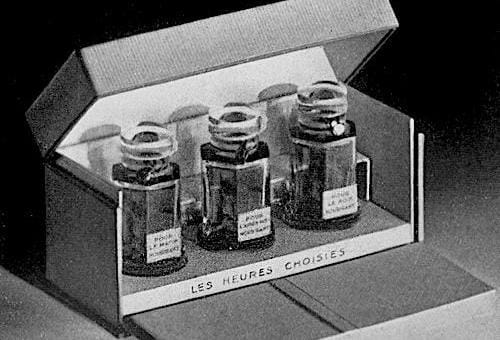
Above: 1932 Houbigant Les Heures Choisies – Pour Le Matin, Pour L’Après Midi, and Pour Le Soir.
Other perfumes were later given the small-bottle treatment. For example Houbigant, Inc. introduced a smaller version of Parfum Idéal into the American market in 1934.
Houbigant also revived an idea it had first introduced back in 1922, a series of perfumed frictions/lotions for the hair. In France, these Lotion Spéciales were said to be particularly useful for waved hair.
America
The effects of the Great Depression were more marked in the United States than they were in France, and Houbigant, Inc. responded to the deepening economic crisis there with a number of structural changes. It closed its Chicago office in 1930, and amalgamated the Houbigant and Cheramy sales through the creation of the Houbigant Sales Corporation in 1932. This new company was based in the Houbigant building at 539 West 45th Street, New York.
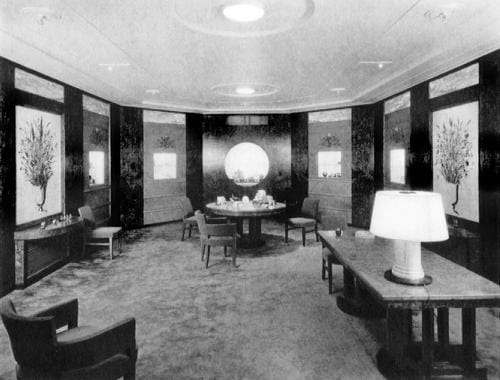
Above: 1938 Houbigant sales room at West 45th Street, New York designed by the architect Vahan Hagopian [1889-1971].
As well as price reductions on some items, Houbigant, Inc. also increased its advertising budget and began sponsoring radio broadcasts over the Blue Network of the National Broadcasting Company (NBC) in 1931. In 1933, the company then adopted a new merchandising plan. This introduced minimum retail prices, and dictated how authorised retailers were to display and sell Houbigant and Cheramy products. Houbigant, Inc. hoped that this would reduce further price cutting and the erosion of their brands.
Houbigant, Inc. also employed another technique commonly used in the Great Depression to improve sales. In 1931, it began selling sets of compacts with patterned lids in a range of colours, the idea being that women would buy the same compact in different colours to match them with colour of their clothing.
Concerned about sales of their face powders saw Houbigant, Inc. begin a campaign promoting its Dull Finish Face Powder in 1933 which was said to “end unlovely shine”. The powder came in the familiar flower basket box but was only available in two fragrances – Quelques Fleurs and Le Parfum Idéal.
Dull Finish Face Powder: “The unique Houbigant texture-blend eliminates all shine—and, by contrast, accents and brightens your make-up, your hair, the sparkle of your eyes.” Shades: Naturelle, Ocre, Rachel, Blanche, Rosée, and Rachel Foncé.
See also: Dull Finish (c.1933)
The Dull finish campaign appears to have garnered some initial success but nothing close to the interest Lady Esther generated with its ‘Bite Test’ campaign which began in 1934.
See also: The Bite Test
Britain
Houbigant products sold in Britain came directly from France so were subject to the increased tariffs levied by the British government during the 1930s to help protect its industries and raise revenue. Despite this prices were reduced on some items. As in America, some products were introduced in smaller sizes but Houbigant also took the more drastic step replacing its distributor, Parfumeries de Paris, with the Perfumery Marketing Company in 1934. Conditions must have continued to be difficult as prices were cut again in 1937, this time across the board.
Products
Houbigant payed a lot more attention to its make-up and skin-care cosmetics during the 1930s. A number of new cosmetic lines were introduced and the company increased the shade ranges of existing make-up items. Many of the new products were tagged with “En Beauté” (In Beauty) starting with a cream rouge (Fard Crème “En Beauté”), a dry rouge (Fard Sec “En Beauté”) and a lipstick (Rouge Tenace) – in 1933. Both the Fard Crème and Fard Sec were scented with Quelques Fleurs.
I know very little about the Fard Crème but given the name and Houbigant’s claim that it was very different to their previous Fard Gras, this makes me suspect that the rouge was formulated as an emulsion rather than a paste.

Above: 1934 Houbigant “En Beauté” Creme Rouge display box.
Rouge Tenace was an indelible lipstick that appears to have taken its lead from the best-selling lipstick, Tangee. Like Tangee, it stained the lips with dyes rather than relying on pigments to colour them. Houbigant went so far as to recommend wiping the lips after the lipstick was applied to ‘avoid the spotty appearance which most lips assume when the greasy coating of ordinary lipstick wears off’.
See also: Tangee
The lipstick was originally sold in a slim push-up gold case but Houbigant added a refillable twist-up case by 1935. The twist-up case, sometimes referred to as a Parisian case, came in a range of coloured lids – Jade, Ivoire, Lapis-Lazuli, and Écaille – so women could harminise them with their clothing.
Unlike Houbigant’s Poudre Comprimée, which was a compressed powder, Fard Sec “En Beauté” was baked. The finished product had a curved rather than a flat surface and it was packaged in a ‘Basket of Flowers’ box rather than a compact. For some reason Houbigant elected to number the shades 1-12 rather than name them. Why it decided to use these older techniques is beyond me but it did allow it to claim that the rouges were hand made.
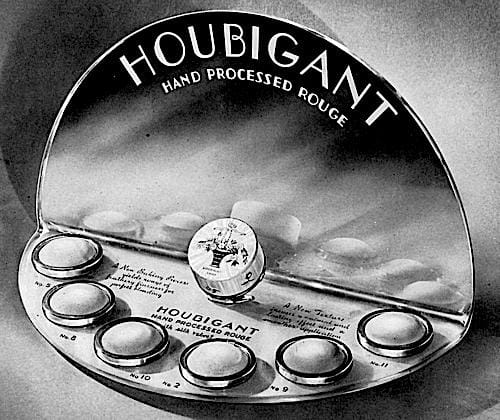
Above: 1934 Display of Houbigant Hand Process Rouges (Dry Rouge, Fard Sec), numbers 5, 8, 10, 2, 9, and 11 (USA). It is possible that fewer shades were available in the United States.
Fard Crème “En Beauté”: “[D]esigned for the ‘natural’ makeup that is the rule today. As easy to spread as an ordinary cream, it is somehow modelled under the finger and makes it easy to obtain the most delicate gradients, the most invisible retouching.” Shades: Capucine, Cyclamen, Anémone, Péche, Bengale, Corail, Amarante, and Grenade.
Fard Sec “En Beauté”: “[E]ntirely new, feathery fine, and log-lasting . . . hence it gives you rouge-rightness for all the day. It invariable blends with your skin-tone correclty, subtly— like color under your skin.” Shades: 1-12.
Rouge Tenace: “[I]t is never obvious, never greasily shining—but rather a natural and lasting intensification of your lip’s own shade and soft texture. Shades: Coquelicot (Poppy), Cerise (Cherry), Rubis (Ruby), and Grenat (Garnet Red), with Naturel (Natural) added in 1935.
In 1934, Houbigant added Lait “En Beauté”, a complexion milk alternative to the earlier Crème “En Beauté”.
Lait “En Beauté”: “Maintains the youthfulness of the skin. a tonic to the skin tissues. an excellent powder base.”
In 1934, Houbigant combined these new cosmetics with its face powders in an extensive “En Beauté” advertising campaign.
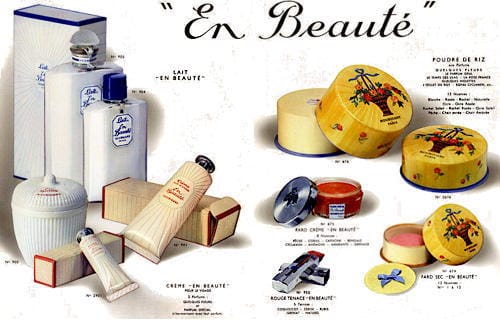
Above: c. 1935 Houbigant “En Beauté”: Lait “En Beauté”, Crème “En Beauté” in a porcelain jar and tubes (Parfum Spécial and Quelques Fleurs), Poudre de Riz, Fard Crème “En Beauté”, Rouge Tenace “En Beauté”, and Fard Sec “En Beauté”.
Houbigant Face Powders (Poudre de Riz) came in nine shades in 1933 – Blanche, Rosée, Rachel, Naturelle, Ocre, Ocre Rosée, Rachel Soleil, Rachel Rosée, and Ocre Soleil. The shades range had increased to twelve by 1935 with the addition of Péche, Chair/Naturelle Ocrée, and Chair/Naturelle Ambrée. Later shades included Dorée, Halée, and Provence.
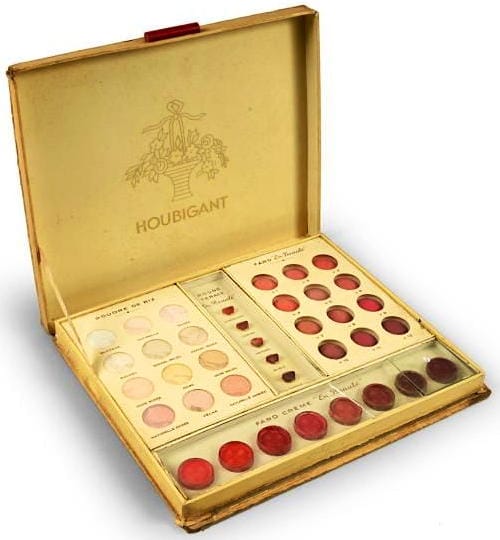
Above: c.1935 Houbigant display box of En Beauté make-up showing 12 shades of Poudre de Riz, 5 shades of Rouge Tenace, 12 shades of Fard Sec, and 8 shades of Fard Crème.
In 1937, Houbigant added Lait d’Orange and Crème d’Orange to the En Beauté range. Both products contained vitamin C and could be used as an alternative to the earlier Lait and Crème “En Beauté”.
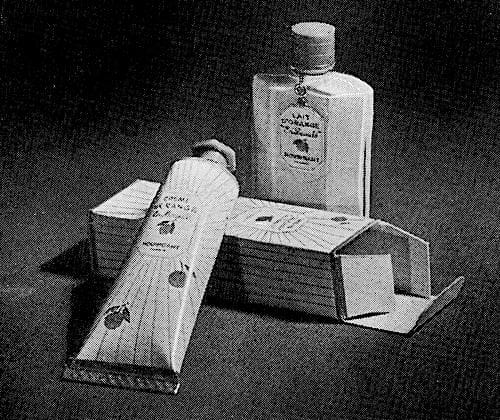
Above: 1937 Houbigant Crème and Lait d’Orange “En Beauté”.
Houbigant advertising in the 1930s very rarely mentioned eye make-up. However, a number of compact designs that Houbigant introduced in the 1930s included cases for mascara. As well as Noir, Brun, and Chatain shades Houbigant added Noir Bleute, a deep blue shade, in 1934.
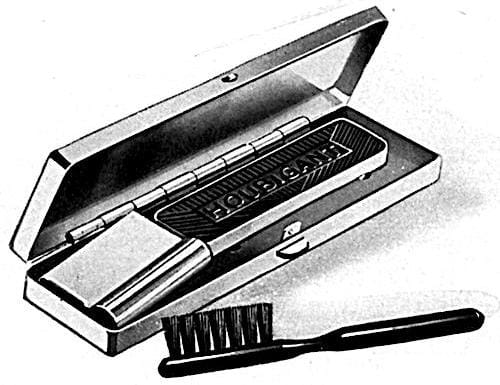
Above: 1931 Houbigant Mascara.
Wartime
As the Germans advanced on Paris, Fernand Javal and his family fled across the border to Lisbon, Portugal where they boarded the S.S. Exeter and sailed to New York arriving there in September, 1940. Fernand Javal’s son, Antoine Alfred Javal [1920-2008], took longer to get the United States, arriving in New York in December, 1941 on the S.S. Guiné out of Casablanca. I do not know if the Javals were practicing Jews but as they had Jewish antecedents that would not have mattered to the Nazis. The relocation to New York probably save their lives.
Travelling with Fernand Javal [1884-1977], his wife Antoinette (Antoinette Lia Aline Javal née Schiller) [1889-1986], and their daughter Anne Maria, was Enrico Donati, his wife Claire and their two daughters, Marina and Sylvia. Donati had become part of the extended Javal family when he married Claire Rose Esther Javal [1910-1985], Fernand Javal’s older daughter, in May 1934. After the wedding, the newlyweds moved to New York where Donati was employed as a trainee manager by Houbigant, Inc. After he was fired for being “too young and aggressive” (Forbes, 1972, p. 68), the couple moved back to Paris where they remained until 1940.
Britain
Britain and France were allies during the Second World War and to help support France, Britain dropped its import tariffs on French goods in March, 1940 a few months after the war broke out in September, 1939. However, Houbigant was not able to take advantage of this for long as France capitulated to the Germans in June, 1940.
British supplies of Houbigant were fully imported so the Perfumery Marketing Company closed its office in Piccadilly in September, 1940 and Houbigant disappeared from Britain and its dominions for the duration of the war. Houbigant would not reestablish a distributor in Britain until 1959.
United States
America did not declare war on Germany until late 1941 so technically was still able to trade with France until then. Unfortunately, I have no information on relations between Houbigant, Inc, in the United States and Parfumerie Houbigant S.A. in France to throw light on this situation but imagine there was very little interaction.
In the United States, Houbigant, Inc. introduced some new products into the American market before the country went to war including a new make-up series called Translucid. Launched in 1941, it was promoted as ‘Sheer Make-up for Sheer Beauty’.
Now, for the first time your own natural skin-tone “glows through.” Your skin reflects a soap-and-water beauty, minus the shine.
(Houbigant advertisement, 1941)
Houbigant, Inc. occasionally claimed that the Translucid line had been in development in France for a number of years but, given its arrival date, the fact that a named perfume was not associated with the range, and that I can find no trace of the line in Europe or Britain after the war, this leads me to suspect it was created in the United States.
The Translucid series debuted with Translucid Foundation Lotion ( a suspension in four shades), Face Powder (seven shades), Dry Rouge (six shades), Lipstick (six shades) and a compact, all packaged in new containers.
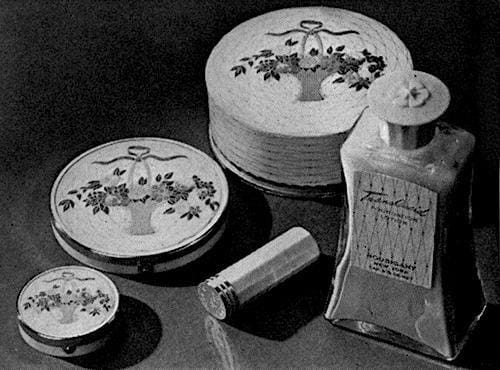
Above: 1941 Houbigant Translucid Face Powder, Compact Powder, Rouge, Lipstick, and Foundation Lotion.
Houbigant Inc. quickly extended the range adding Translucid Eau de Cologne, and Translucid Sun-Filter Lotion later in 1941. Further additions were Translucid Foundation-Tone, Skin Freshener, Mascara, Whipped Cream Rouge, Eyebrow Pencil, and Eye Shadow (five shades) (1942); Translucid Special Sheer Texture Cleansing Cream, and Special Emollient Retiring Cream (1943); and Cream-Tone (1945).
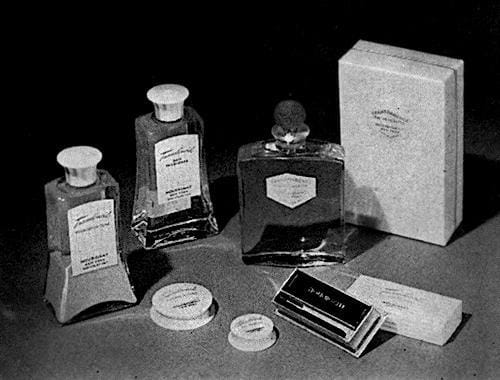
Above: 1942 Houbigant Translucid Foundation-Tone, Freshener, Whipped Cream Rouge, Eye Shadow, Mascara, and Transparence, a toilet-water.
Translucid Foundation Lotion: “An entirely new powder-base, starting point of a Translucid make-up. Apply lightly to face and neck with finger tips. Keeps make-up fresh for hours.” Shades Special Light, Light, Medium, and Dark.
Translucid Face Powder: “[M]icro-milled for perfect smoothness and clinging quality. In addition it is sheer-sifted to reward with a clear, even powder-film that permits the skin’s natural tones to ‘glow through’.” Known shades: Natural, Rachel, Rachel Rosée, Pêche, Champagne Rosée, Pêche Soleil, Copper Tan, Sienna, and Beige.
Translucid Lipstick: “Rich and creamy, it smooths on so easily . . . stays on so long!” Shades: Ebony Rose, Autumn Red, Rose Indigo, True Red, Ruby, and Deep Red Ruby. Later additions included Cherry, Pink Cyclamen, and Deep Cyclamen.
Translucid Eau de Cologne: “[A] delightful, unobtrusive aid to good grooming.”
Translucid Sun-Filter Lotion: “A soothing, non-greasy preparation with an emollient base, which reduces the burning effects of the sun’s rays. Delicately scented, long lasting . . . an indispensable aid to your summer comfort.”
Translucid Foundation-Tone: “Smooth just a tiny bit of this kiss-smooth preparation over your face and throat . . . for the look of ‘glowing through’ loveliness that Translucid achieves for you.” Shades: Light, Medium, and Dark, with Sienna added in 1942.
Translucid Special Sheer Texture Cleansing Cream: “Soothes as it cleanses. This Is the very special cream that you love to use—a sheer texture, soothing cleansing cream.”
Translucid Special Emollient Retiring Cream: “Rich In fine oils, to supplement the natural oils of your skin. It soothes and softens . . . helps to keep the face and throat petal-smooth.”
Translucid Cream-Tone: “[D]efinitely non-drying, non-caking. This tinted make-up cream is as fine and delicate aa gossamer in texture . . . goes on quickly, tidily and lasts and lasts to natural loveliness! It’s an excellent ‘cover-up’ for minor skin blemishes, too.” Shades: Light, Medium, and Dark.
Translucid Whipped Cream Rouge: “[T]his light and fluffy cream rouge that smooths on instantly, perfectly, and seems a part of you! Wear it for sheer beauty.” Shades: As for lipstick.
Post war
Information on Houbigant’s activities in France after the war are scarce. Some have suggested that the factory in Neuilly-sur-Seine was bombed during the war and then closed down but I have no conformation of this. Even if this is true manufacturing must have started up somewhere else.
However, it does appear that one legacy of the war was the general decline in the role of Parfumerie Houbigant, France. In 1983, Chemist & Druggist reported that only two of the new fragrances introduced by Houbigant after the war were totally developed in Paris – Ciao (1980) and Raffinée (1982) (Chemist & Druggist, March, 1983, p. 394).
Products
Due to the lack of information on operations in France I will largely restrict my discussion of Houbigant products after the war to the United States. There are only a few lines added there after 1945 that are of interest to me as the company elected to neglect its make-up and skin-care lines and focus instead on perfumes and fragrance products. Translucid looks to have been the only cosmetic range that underwent some development and even there it only seems to have lasted through to the 1960s.
Chantilly
Houbigant’s most important perfume in the immediate post-war period was Chantilly, developed by Marcel Billot. Like Translucid it first appeared in America in 1941 and does not appear to have been available in France until after the war.
The Chantilly range began with four products – a perfume, eau de toilette, dusting powder, and liquid skin sachet. Four post-war Chantilly products introduced into America that are of some interest were: Chantilly Face Powder (1947) packaged in a pink box embellished with a Chantilly lace pattern topped with a bow, Chantilly Liquid Cream Deodorant (1953), Houbigant Body-Tone (1954), and Houbigant Lotion Whip (1954). Body-Tone was an after-bath skin lotion and was one of the first products that Houbigant, Inc. advertised on television, while Lotion Whip as an early Houbigant aerosol. Both Body-Tone and Body whip were scented with Chantilly.
Chantilly Face Powder: “[A] sheer-sifter, delicately clinging face powder scented through and through with Chantilly.” Shades: Rachel, Pêche, Champagne Rosée, Pêche Soleil and Sienna.
Chantilly Liquid Cream Deodorant: “Protect yourself against perspiration odor the pleasant, sure, feminine way. The deodorant contains skin cream base, is soothing to use, Won't drip in use or cake afterwards. Non-sticky . . . safe for normal skin and fabrics. Supplement freshness with Houbigant
body powder—it leaves the skin silken-soft and delightfully fragrant.”
Houbigant Body-Tone: “This shell-pink, translucid formula tingles and refines, softens and smooths. It contains a moisture-giving element that lubricates without leaving a trace of stickiness.”
Houbigant Lotion-Whip: “[A] whipped cream for hand care packaged in an aerosol can. Just press the button, and you have a wonderful Chantilly-scented cream that softens and soothes. It also leaves a protective film to guard against detergents, soaps, cold weather.”
Quelques Fleurs
Quelques Fleurs continued to be a popular Houbigant fragrance and Houbigant, Inc. added a few new items including a Quelques Fleurs Deodorant Stick (1952) and a new version of Quelques Fleurs Hand Lotion (1954) containing allantoin.
Quelques Fleurs Hand Lotion: “[C]ontains allantoin, which is said to stimulate the formation of new skin tissue and to heal scratched, cut, cracked or chapped hands.”
In the United States, a number of Quelques Fleurs lines were promoted by including free seed packets with them which could be used to grow a miniature French flower garden. As Quelques Fleurs translates as ‘Some Flowers’ this was an inventive promotion.

Above: 1956 Houbigant Quelques Fleurs Refreshence, Toilet Water, Perfume and Hand Lotion with seeds and planting instructions.
In 1957, Houbigant built on its original idea by sponsoring a television program called ‘Arrangement in Flowers’ starring J. Gregory Conway [1907-1974], who had toured America in 1956 giving flower-arranging demonstrations for Houbigant.
Enrico Donati
After Enrico Donati arrived in New York in 1940 with his wife, children and the Javals he became an American citizen and set up Donrico, Inc., a printing company, at 438 West 37th Street, New York. Donrico sprung from Donati’s interest in graphic arts which had developed following his return to Paris after his time with Houbigant, Inc. in New York in 1934.
Donrico, Inc. produced quality packaging and was best known for its embossed work. A number of cosmetic companies engaged its services over the years including Elizabeth Arden, Revlon, Avon, and Hazel Bishop. During this time Donati took up painting and became a member of the New York schools of surrealism, constructivism, and abstract expressionism. His first exhibition was in 1942 and his works are now found in major art galleries.
When Houbigant began to falter in the late 1950s, Donati was asked to join the board of Houbigant, Inc. but only accepted after he was sold shares in the company. Following further stock purchases he gained a controlling interest in Houbigant in 1965 (Forbes, 1972) and became its chief executive office. Donati’s acquisition of Houbigant appears to have included the French business and a large number of Houbigant trademarks were transferred from Paris to New York in 1969.
After gaining control of Houbigant, Donati set about resurrecting the brand. He restored the image of two of Houbigant’s best-selling lines – Quelques Fleurs and Chantilly – introduced new fragrances, and redesigned a good deal of the product packaging. He also reorganised the company’s American sales force and moved Houbigant’s manufacturing there to Ridgefield, New Jersey in 1971.
Houbigant, Inc. also took control of Houbigant’s operations in Britain after it bought Abbey Parfumerie Co. Ltd in 1968 and changed its name to Houbigant Ltd. Abbey had been appointed Houbigant’s distributor to the United Kingdom and Eire in 1959.
Two product developments that occurred during the Donati period deserve special attention. The first was the creation of the Monsieur Houbigant range of men’s toileties in 1967, the second was the creation of the Alyssa Ashley division in 1968.
Houbigant introduced two colognes for men in 1967 – Yama and Monsieur Houbigant. Monsieur Houbigant appears to have been more successful and it was expanded into a complete men’ range which included shaving soaps, after shaves, talcum powders, deodorants, and moisturisers.

Above: 1974 Monsieur Houbigant (UK).
The Alyssa Ashley division was founded after Donati had divorced his first wife and remarried. A new daughter from that marriage, Alexandra Donati, appears to have been the inspiration for the Alyssa Ashley name – Alyssa being a version of Alexandra with Ashley referring to her having blonde hair. The range began with Musk, a unisex, single note fragrance that was very successful with the youth culture of the 1960s and 1970s.
Later developments
In 1983, Houbigant underwent a major reorganisation with the group divided into three parts. The Alyssa Ashley division covered the marketing of single note fragrances such as Musk, Ambergris, Patchoili, Tea Rose, and Les Fleurs; Houbigant International looked after products such as Quelques Fleurs, Chantilly, Essence Rare and Monsieur Houbigant; and Houbigant Paris took charge of newer fragrances like Ciao and Raffinée in the hope that the French connection might position these fragrances more upmarket.
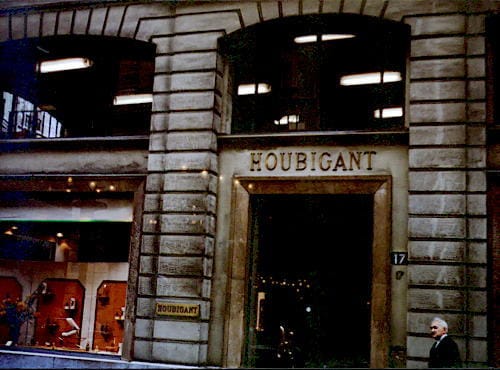
Above: Houbigant at 17 Rue du Faubourg Saint-Honoré.
By the 1990s, Houbigant was in trouble once more and it filed for Chapter 11 bankruptcy protection in the United States in 1993 and was put into receivership in 1994. Renaissance Cosmetics, Inc. continued to manufacture some Houbigant fragrances but it also went bankrupt in 1999. Some Houbigant and Alyssa Ashley fragrances still survive. Both lines are currently owned by the Perris Group, a firm founded by Michele Perris in 1981.
Timeline
| 1930 | Houbigant, Inc. closes its Chicago office. |
| 1933 | Houbigant Sales Corporation established in New York. New Products: Fard En Beauté; Fard Sec En Beauté; and Rouge Tenace. |
| 1934 | Perfumery Marketing Company replaces Parfumeries de Paris as Houbigant’s British agents. New Products: Lait En Beauté. |
| 1940 | Perfumery Marketing Company office in London closes. |
| 1941 | New Products: Translucid Foundation Lotion, Face Powder, Dry Rouge, Lipstick, Eau de Cologne, and Sun-Filter Lotion (USA). |
| 1942 | New Products: Translucid Skin Freshener, Mascara, Whipped Cream Rouge, Eyebrow Pencil, and Eye Shadow (USA). |
| 1943 | New Products: Translucid Special Sheer Texture Cleansing Cream, and Special Emollient Retiring Cream (USA). |
| 1945 | New Products: Translucid Cream-Tone (USA). |
| 1947 | New Products: Chantilly Face Powder (USA). |
| 1953 | New Products: Chantilly Liquid Cream Deodorant (USA). |
| 1954 | New Products: Body-Tone; and Lotion Whip (USA). |
| 1959 | Abbey Parfumerie becomes Houbigant’s distributor in the United Kingdom and Eire. |
| 1965 | Enrico Donati acquires a controlling interrest in Houbigant. |
| 1968 | Houbigant Inc. acquires Abby Parfumerie which then becomes Houbigant Ltd. |
| 1971 | Houbigant Inc. opens a new factory in Ridgefield, New Jersey. |
| 1994 | Houbigant Inc. goes into receivership. |
First Posted: 11th August 2024
Last Update: 26th August 2024
Sources
The American Perfumer & Essential Oil Review. (1906-1955). New York: Robbins Perfumer Co. [etc.].
Billot, M. (1966). 75 years of perfume creations. American Perfumer and Cosmetics, 81(April), 51-56.
The Drug and Cosmetic Industry. (1932-1997). New York: Harcourt Brace Jovanovich [etc.].
Houbigant, Inc. (C.1933). Dull finish make-up [Booklet]. USA: Author.
La parfumerie française et l’art dans la présentation. (1925). Paris: La Revue des Marques de la Parfumerie et de la Savonnerie.

Fernand René Javal [1884-1977].
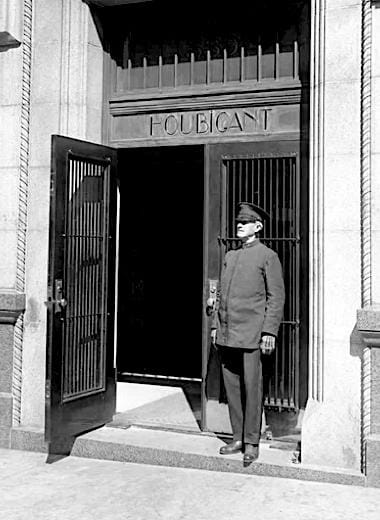
c.1930 Entrance to Houbigant Building in New York.
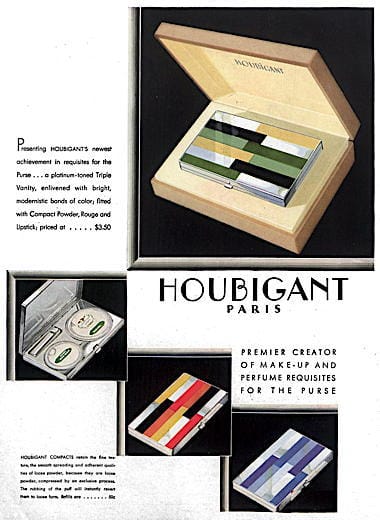
1931 Houbigant Compacts (USA).

1931 Houbigant Lotion Spéciale.
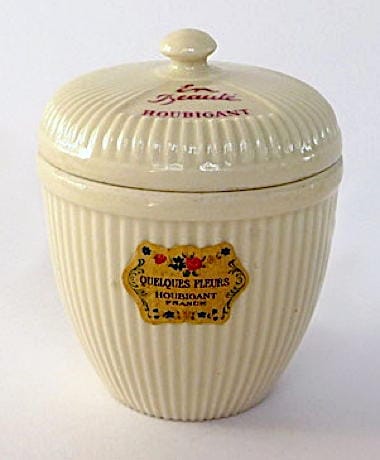
Crème En Beauté in a porcelain pot.
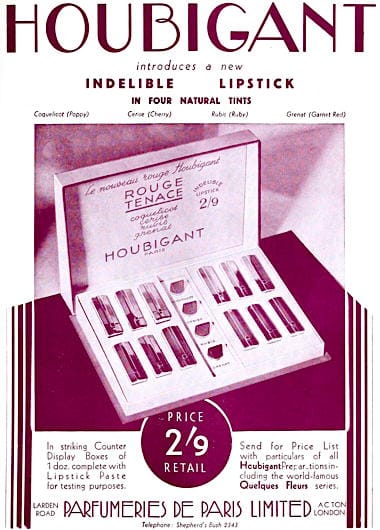
1933 Trade advertisement for Houbigant Rouge Tenace (UK).
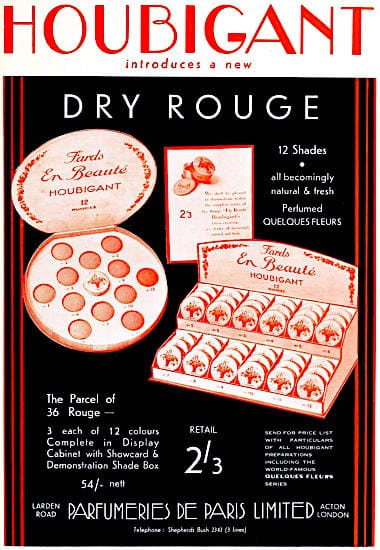
1933 Trade advertisement for Houbigant Dry Rouge (Fard Sec) (UK).

c.1934 Houbigant powder boxes for Présence, Bois Dormant, Au Matin, and Fougère Royal.

1934 Houbigant dull finish make-up (USA).
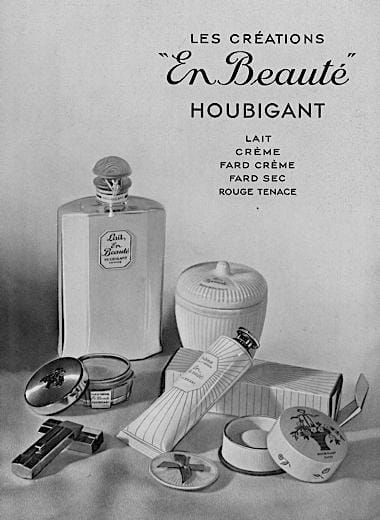
1934 Houbigant En Beauté.

Houbigant museum display showing Mascara, Face Powder, Fard Comprimée (compressed rouge) and a display box for Fard Sec (dry rouge).

1934 Houbigant En Beauté (Argentina).
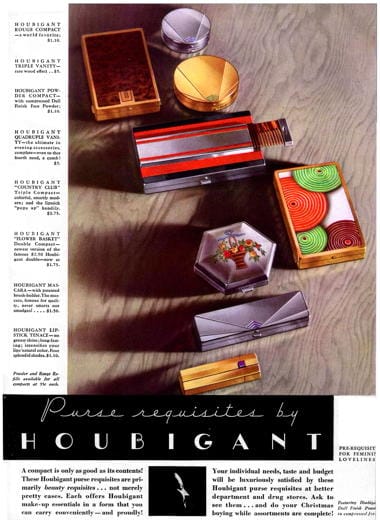
1935 Houbigant purse requisites (USA).
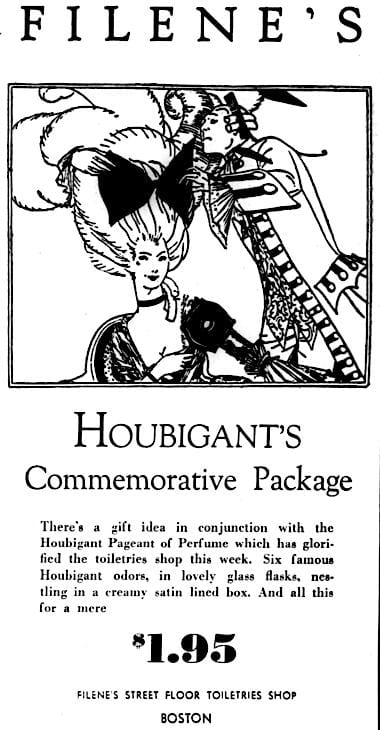
1935 Houbigant Pageant of Perfume [USA]. I assume Houbigant used objects from Fernand Javal’s vintage perfume collection that he had begun in 1919. These had been used in Houbigant’s sesquicentennial celebrations in 1925.
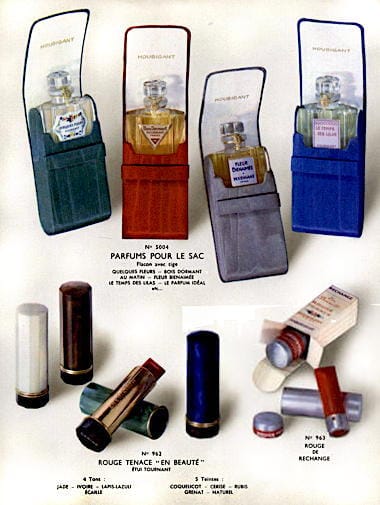
c.1935 Houbigant Parfums for the purse or handbag and Rouge Tenace “En Beauté” in Ivoire, Écaille, Jade, and Lapis-Lazuli cases with refill.
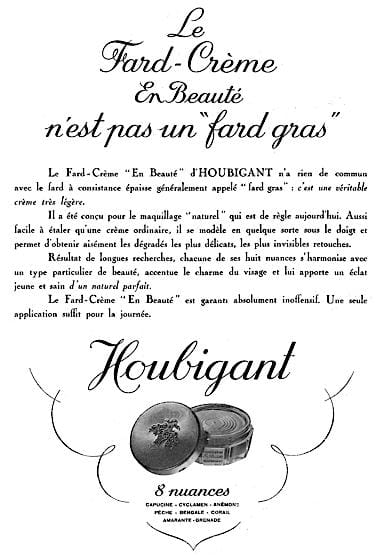
1937 Houbigant Fard Cr&egrsve;me.
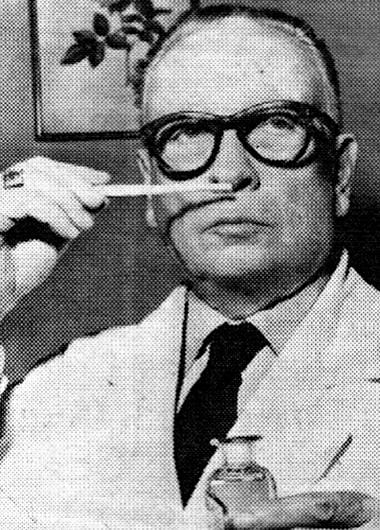
Marcel Billot [1888-c.1980], the perfumer who created Chantilly. He retired from Houbigant in 1960.
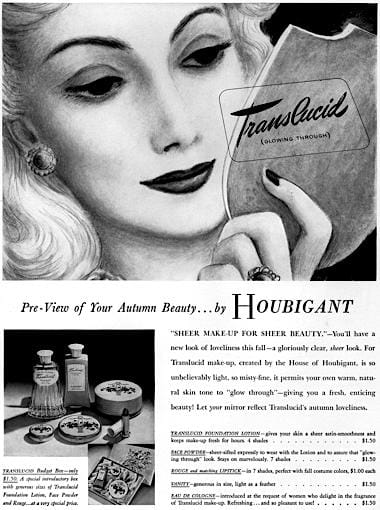
1941 Houbigant Translucid.
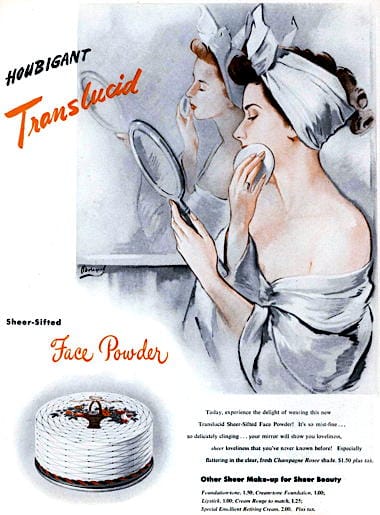
1945 Houbigant Translucid Face Powder.
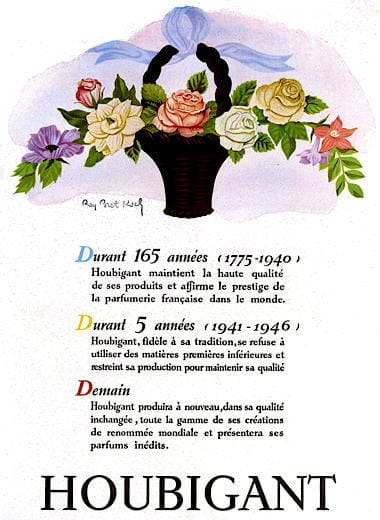
1946 Houbigant.
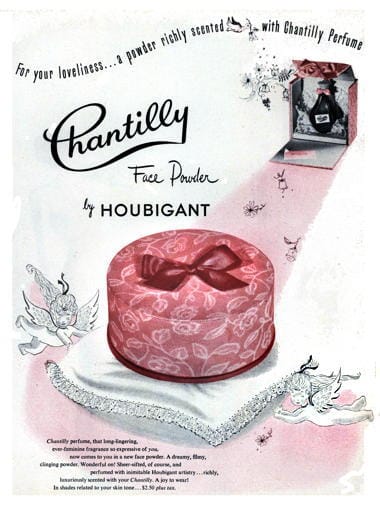
1947 Houbigant Chantilly Face Powder (USA).
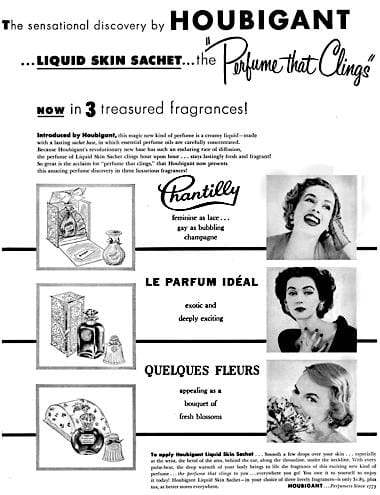
1952 Houbigant Liquid Skin Sachets (USA).
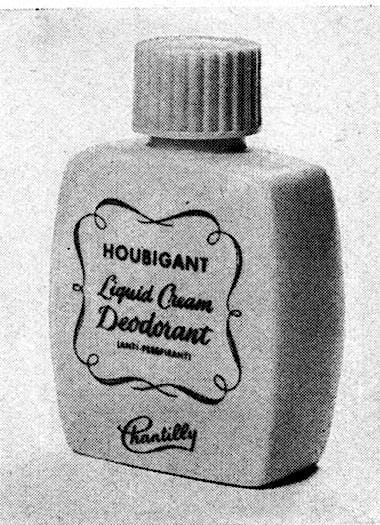
1953 Chantilly Liquid Cream Deodorant (USA).
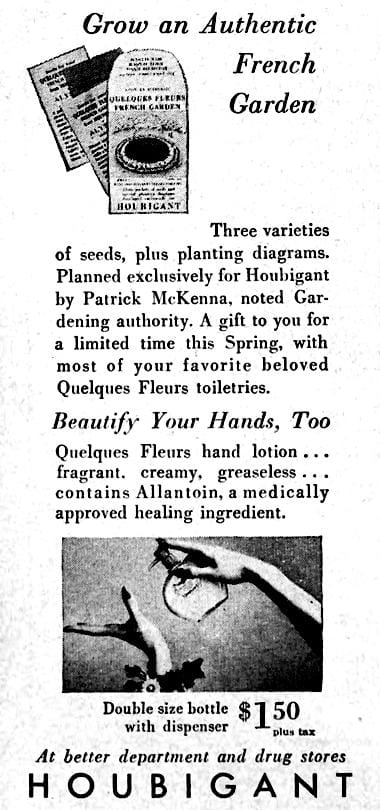
1958 Houbigant Quelques Fleurs Hand Lotion with dispenser (USA).
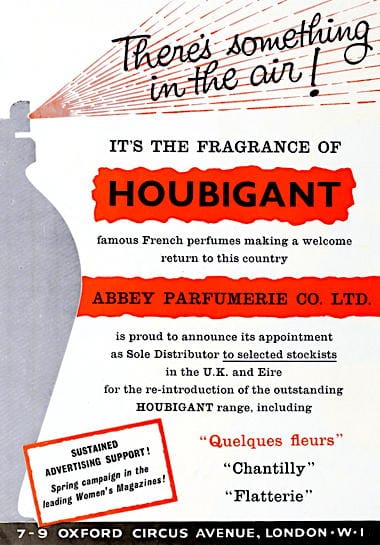
1959 Trade advertisment announcing Abbey Parfumerie as Houbigant’s new distributor (UK).

Enrico Francesco Donati [1909-2008] in his studio.
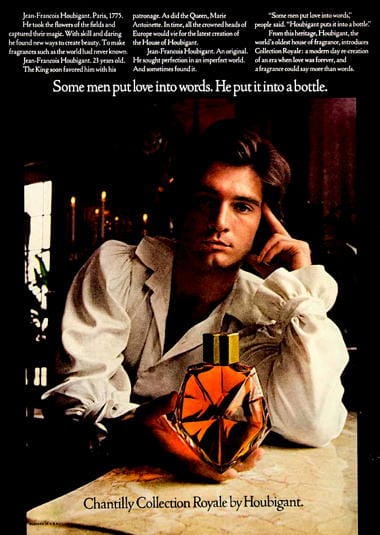
1969 Houbigant Chantilly Collection Royale (USA).
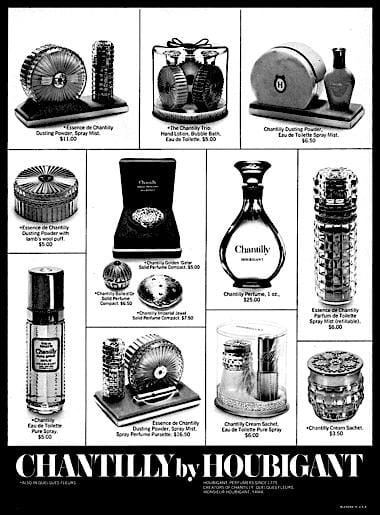
1970 Houbigant Chantilly (USA).
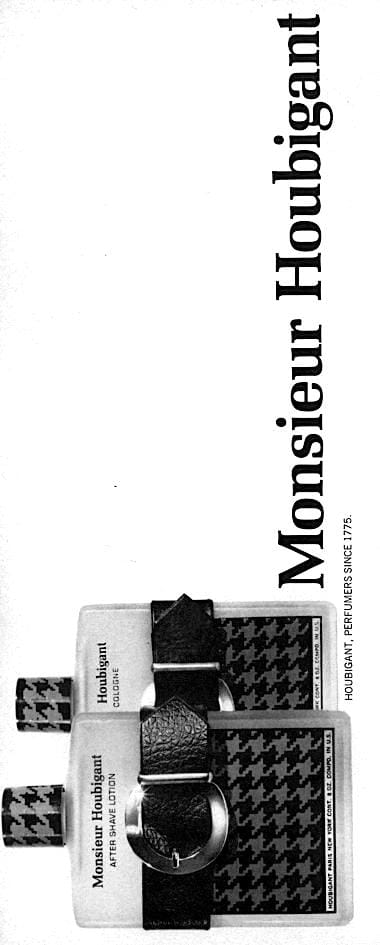
1970 Monsieur Houbigant (USA).
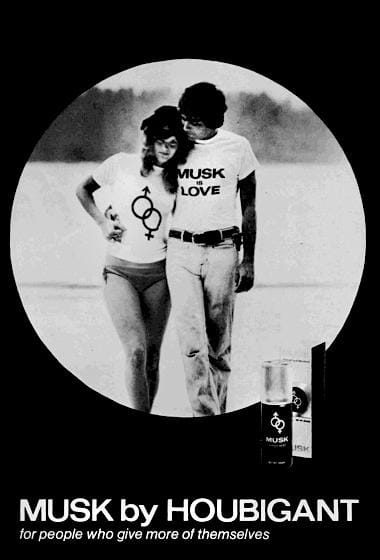
1974 Alyssa Ashley Musk.
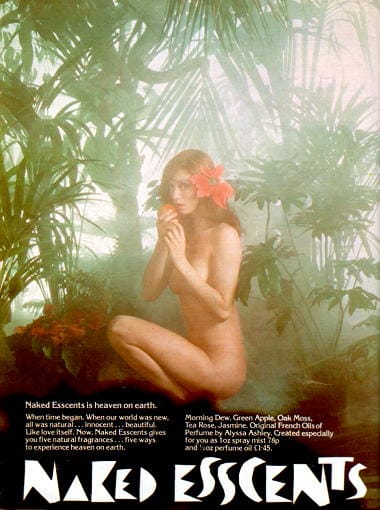
1974 Alyssa Ashley Naked Esscents (UK).
